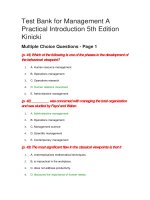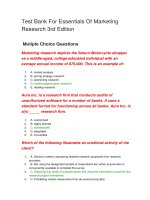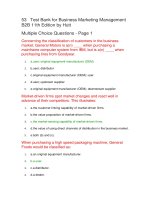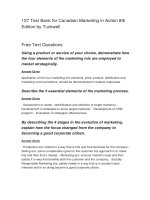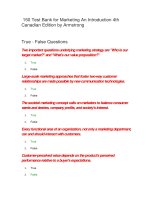Test bank for pharmacology for nurses a pathophysiologic approach 3rd edition by adams
Bạn đang xem bản rút gọn của tài liệu. Xem và tải ngay bản đầy đủ của tài liệu tại đây (47.92 KB, 8 trang )
Full file at />CHAPTER 1
1.1 The nurse is teaching a pharmacology class to student nurses. What does the nurse
include as key events in the history of pharmacology? Select all that apply.
1. Modern pharmacology began in the early 1600s.
2. Initial drugs included morphine, cocaine, and penicillin.
3. Early researchers used themselves as test subjects.
4. Pharmacologists synthesized drugs in the laboratory in the twentieth century.
5. The initial intention of pharmacology was to relieve human suffering.
Answer: 3, 4, 5
Rationale: The early roots of pharmacology included the application of products to
relieve human suffering, and early researchers used themselves as test subjects. Initial
drugs included morphine, colchicines, curare, and cocaine, but not penicillin. Modern
pharmacology began in the early 1800s, not the 1600s. By the twentieth century,
pharmacologists could synthesize drugs in the laboratory.
Implementation
Physiological Integrity
Application
Objective: 1-1
1.2 The student nurse asks the nursing instructor why he needs to take anatomy and
physiology, as well as microbiology, when he only wants to learn about pharmacology.
What is the best response by the instructor?
1. “You must learn all, since those subjects, as well as pharmacology, are part of the
curriculum.”
2. “Because pharmacology is an outgrowth of those subjects.”
3. “Because an understanding of those subjects is essential to understanding
pharmacology.”
4. “Knowledge of all those subjects will prepare you to provide the best patient care,
including the administration of medications.”
Answer: 3
Rationale:ᄂIt is essential for the nurse to have a broad knowledge base of many sciences
in order to learn pharmacology. The nurse must learn anatomy, physiology, and
microbiology to understand pharmacology, not because they are part of the curriculum.
Pharmacology is an outgrowth of anatomy, physiology, and microbiology, but this is not
the reason for the nurse to learn them. Knowledge of anatomy, physiology, and
microbiology prepares the nurse to understand pharmacology, not to provide care such as
administration of medications.
Implementation
Physiological Integrity
Application
Objective: 1-2
1.3 The nursing instructor is teaching a pharmacology class to student nurses. The current
focus is pharmacology and therapeutics. The nursing instructor determines that learning
has occurred when the students make which comments? Select all that apply.
1. “Pharmacology is the study of medicines.”
2. “Therapeutics is the study of the therapeutic use of drugs.”
3. “Pharmacology is the use of drugs to relieve suffering.”
4. “Therapeutics is the study of drug interactions.”
5. “Pharmacology is the study of drugs to prevent disease.”
Answer: 1, 3
Rationale:ᄂPharmacology is the study of medicines and the use of drugs to relieve
suffering. Therapeutics is the study of disease prevention and treatment of suffering.
Pharmacotherapy is the application of drugs for the purpose of disease prevention.
Evaluation
Physiological Integrity
buy this full document at
Full file at />Application
Objective: 1-3
1.4 The nurse administers a vaccine to a child. What is the best understanding of the
nurse as it relates to the manufacture of this vaccine?
1. The vaccine is most commonly synthesized in a laboratory.
2. The vaccine is naturally produced in animal cells or microorganisms.
3. The vaccine is produced by natural plant extracts in the laboratory.
4. The vaccine is produced by a combination of animal and plant products.
Answer: 2
Rationale:ᄂVaccines are naturally produced in animal cells, microorganisms, or by the
body itself. Vaccines are not synthesized in a laboratory. Vaccines are not produced by
natural plant extracts. Vaccines are not produced by a combination of animal and plant
products.
Evaluation
Physiological Integrity
Application
Objective: 1-4
1.5 The elderly client has gastrointestinal bleeding. The client says to the nurse “I don’t
understand this. All I did was take ibuprofen (Advil) for my arthritis.” Which plan would
be best as it relates to the nurse’s education of this client?
1. A plan to teach the client to substitute safer drugs like acetaminophen (Tylenol).
2. A plan to teach the client to use drugs that bypass the gastrointestinal system, like
topical drugs.
3. A plan to teach the client to obtain physician approval prior to the use of over-thecounter (OTC) medications.
4. A plan to teach the advantages and disadvantages of ibuprofen (Advil).
Answer: 4
Rationale:ᄂSince elderly clients account for the use of about 40% of all over-the-counter
(OTC) medications, it is essential for the nurse to teach clients about the advantages, and
the disadvantages, of these medications. Substitution of other drugs may be beneficial,
but this cannot be done in all situations. The use of topical drugs may be an option, but
the drug a client needs may not be available in this form. It is not a realistic plan to expect
clients to contact their physician prior to taking any over-the-counter (OTC) medication.
Planning
Physiological Integrity
Application
Objective: 1-5
1.6 The student nurse is preparing for the first pharmacology exam. In planning for this
exam, what is most important for the student nurse to remember about the Food, Drug,
and Cosmetic Act?
1. It prevented the sale of drugs that had not been thoroughly tested before marketing.
2. It helped standardize the quality of drugs and cosmetics.
3. It gave the government the power to control the labeling content of medications.
4. It prohibited the sale of drugs labeled with false therapeutic claims that could defraud
the public.
Answer: 1
Rationale:ᄂIn 1938, Congress passed the Food, Drug, and Cosmetic Act. This was the
first law preventing the sale of drugs that had not been thoroughly tested before
marketing. The Food, Drug, and Cosmetic Act did not standardize the quality of drugs
and cosmetics. The Pure Food and Drug Act gave the government the power to control
the labeling content of medications. The Sherley Amendment prohibited the sale of drugs
labeled with false therapeutic claims that could defraud the public.
Planning
Physiological Integrity
buy this full document at
Full file at />Application
Objective: 1-6
1.7 The pharmaceutical representative comes to the physician’s office and says his
company’s pharmaceutical laboratory is marketing a drug that does not need approval by
the Food and Drug Administration (FDA). What is the best response by the nurse?
1. “Is your pharmaceutical laboratory private? Only public pharmaceutical laboratories
need approval from the Food and Drug Administration (FDA).”
2. “Your pharmaceutical laboratory must be involved in academic research because they
are exempt from approval by the Food and Drug Administration (FDA).”
3. “Is this an over-the-counter (OTC) drug? They do not need approval by the Food and
Drug Administration (FDA).”
4. “Any pharmaceutical laboratory in America must have approval from the Food and
Drug Administration (FDA) before marketing a drug.”
Answer: 4
Rationale:ᄂAny pharmaceutical laboratory, whether private, public, or academic, must
obtain approval from the Food and Drug Administration (FDA) before marketing a drug.
Private pharmaceutical laboratories must obtain approval from the Food and Drug
Administration (FDA) before marketing a drug. Pharmaceutical laboratories involved in
academic research must obtain approval from the Food and Drug Administration (FDA)
before marketing a drug. Pharmaceutical laboratories that manufacture over-the-counter
(OTC) drugs must obtain approval from the Food and Drug Administration (FDA) before
marketing these drugs.
Implementation
Physiological Integrity
Application
Objective: 1-7
1.8 The nurse is employed by the Food and Drug Administration (FDA), and is involved
in clinical investigation. What is the primary role of the nurse in this phase of the review
and approval process by the FDA?
1. To perform tests on human cells cultured in the laboratory
2. To perform tests on the population-at-large
3. To perform tests on human clients
4. To perform tests on various species of animals
Answer: 3
Rationale:ᄂClinical investigation includes performing tests on healthy volunteers, and
later, on selected clients with a particular disease. Performing tests on human cells
cultured in the laboratory is the preclinical investigation stage. Performing tests on the
population-at-large is the stage of post-marketing surveillance. Performing tests on
various species of animals is the preclinical investigation stage.
Assessment
Physiological Integrity
Application
Objective: 1-8
1.9 The student nurse is taking a pharmacology course and studying about the Food and
Drug Administration (FDA). What has the student learned about how the FDA has
decreased the amount of time involved in bringing a new drug to the market?
1. The Food and Drug Administration (FDA) is not as strict as it once was with regard to
drug approval.
2. Drug manufacturers are required to pay yearly user fees, which allow the Food and
Drug Administration (FDA) to hire more employees to increase its efficiency.
3. Since consumers have demanded more drugs, the Food and Drug Administration
(FDA) has streamlined the review/approval process.
4. Drug manufacturers are required by the Food and Drug Administration (FDA) to test
more drugs on an annual basis.
Answer: 2
buy this full document at
Full file at />Rationale:ᄂIn 1992, the Prescription Drug User Fee Act was passed. This required drug
manufacturers to provide yearly product user fees so the Food and Drug Administration
(FDA) could restructure, hire more employees, and operate more efficiently. The Food
and Drug Administration (FDA) is just as strict now as it always was with regard to drug
approval. The Food and Drug Administration (FDA) has not streamlined the
review/approval process. The Food and Drug Administration (FDA) does not require
drug manufacturers to test more drugs on an annual basis.
Evaluation
Physiological Integrity
Application
Objective: 1-9
1.10 The student nurse is studying the difference between the American and Canadian
drug approval processes. What is the student nurse’s best understanding of the difference
between these two governments in the drug approval process?
1. America incorporates the private and government sectors; Canada uses only the
government sector.
2. There is minimal difference; they both rely extensively on government resources.
3. America has much stricter guidelines than Canada for approving drugs for the public.
4. Canada has much stricter guidelines than America for approving drugs for the public.
Answer: 1
Rationale:ᄂHealth Canada is the federal department that works in partnership with
provincial and territorial governments. There are no private companies involved in the
process. In America, drug approval involves the government (the Food and Drug
Administration (FDA), as well as private drug companies. In America, private as well as
government resources are used. America does not have stricter guidelines than Canada
for approving drugs for the public. Canada does not have stricter guidelines than America
for approving drugs for the public.
Evaluation
Physiological Integrity
Application
Objective: 1-10
1.11 The student nurse has completed an initial pharmacology course and tells the
nursing instructor that it was difficult and she is glad it is over. What is the best response
by the nursing instructor?
1. “It really isn’t over; you should take a graduate course next.”
2. “It may be over, but now you must apply what you have learned to patient care.”
3. “Learning is always painful, but we must continue anyway.”
4. “Learning is gradual and continuous; we never completely master all areas of
pharmacology.”
Answer: 4
Rationale:ᄂLearning pharmacology is a gradual, continuous process that does not end
with graduation. Never does one completely master every facet of drug action and
application. There is no reason for the student nurse to take a graduate level
pharmacology course at this time. It is true that the student must apply what has been
learned to patient care, but this response implies that learning is over. Learning is not
always painful.
Implementation
Physiological Integrity
Application
Objective: 1-2
1.12 The client says to the nurse “My wife and I take the same drug, but we have
different side effects. “Are we doing something wrong?” What is the best response by the
nurse?
1. “No. Differences such as your sex can result in different side effects.”
2. “I’m not sure. Maybe the drug is not the same; you should check it.”
buy this full document at
Full file at />3. “Possibly. This could happen if one uses generic or brand name drugs.”
4. “I’ll have to check. What is the name of the drug you were using?”
Answer: 1
Rationale:ᄂDrugs may elicit different responses depending on individual client factors
such as age, sex, body mass, health status, and genetics. Asking the client to check a
medication is fine, but this does not answer the client’s question. There are differences
between some generic and brand name drugs, but this is not the best answer. The nurse
should not have to check the drug; basic knowledge should include knowing that the sex
of clients can result in different side effects.
Implementation
Physiological Integrity
Application
Objective: 1-4
1.13 The client comes to the emergency department with a myocardial infarction. The
client’s husband tells the nurse that his wife has been taking calcium carbonate (Tums)
for years for what she thought was indigestion. What is the best response by the nurse?
1. “Why did you let her do that? She should have seen a doctor.”
2. “Well, I am glad she is here, as it certainly wasn’t indigestion.”
3. “Your wife was self-diagnosing, which is generally not a good idea.”
4. “Your wife should not have self-diagnosed herself. I hope she will be okay.”
Answer: 3
Rationale:ᄂClients take over-the-counter (OTC) drugs for many reasons. Self-treatment
is sometimes ineffective, and the potential for harm may increase if the disease is allowed
to progress. Asking the husband why he let his wife take Tums is non-therapeutic and too
accusatory; do not ask “why” questions. Telling the husband that “it certainly wasn’t
indigestion” is judgmental and will alienate the client and husband. Telling the husband
“I hope she will be okay” is a very frightening response that implies she might die, and
this is non-therapeutic.
Implementation
Physiological Integrity
Application
Objective: 1-5
1.14 The nurse is teaching a class for clients about over-the-counter (OTC) medications.
The nurse determines that education has been effective when the clients make which
statement?
1. “We should not take any over-the-counter (OTC) medicine without first calling and
checking with the doctor’s office.”
2. “We must read all the directions on the label and call the doctor’s office if they are not
clear.”
3. “Medicines that are available over-the-counter (OTC) are really safe, or they would be
prescription medicines.”
4. “We should always ask the pharmacist about how to take the over-the-counter (OTC)
medicine.”
Answer: 2
Rationale:ᄂIn most cases, clients may treat themselves safely if they carefully follow
instructions included with the medication. It is not realistic to expect clients to call the
doctor’s office before taking any over-the-counter (OTC) medicine. Most OTC medicines
have a high margin of safety, but none are considered completely safe. Asking the
pharmacist is a good idea, but does not replace reading the label directions. Also, the
pharmacist might not always be in the store when the medicine is purchased.
Evaluation
Physiological Integrity
Application
Objective: 1-5
buy this full document at
Full file at />1.15 The client has skin lesions that have not responded to prescription drugs. He tells the
nurse he has heard about some research going on with a new drug and questions why he
can’t take it. What is the best response by the nurse?
1. “Maybe you could contact the drug company about becoming involved in a clinical
trial.”
2. “Your skin lesions really aren’t that bad, but maybe the new drug will be available
soon.”
3. “I know it is frustrating, but the Food and Drug Administration (FDA) approval
process is in place to ensure that drugs are safe.”
4. “The Food and Drug Administration (FDA) has very strict rules about new drugs; it is
important to be patient regarding the review/approval process.”
Answer: 3
Rationale:ᄂAlthough the public is anxious to receive new drugs, the fundamental priority
of the Food and Drug Administration (FDA) is to ensure that drugs are safe. Also, telling
the client that the nurse knows he is frustrated is therapeutic because it communicates that
the nurse recognizes what he is feeling. The client could contact the drug company, but
this response fosters false hope as he may not be a viable candidate for this drug. Telling
the client his skin lesions “aren’t that bad” is a non-therapeutic response; the client’s
perception is his reality. Telling the client to be patient is a condescending response, the
client wants relief from the skin condition.
Implementation
Physiological Integrity
Application
Objective: 1-7
1.16 What percentage of Americans takes at least one prescription drug per year?
1. 10%
2. 25%
3. 40%
4. 50%
Answer: 4
Rationale: About half of Americans take prescription drugs while about 17% takes at
least three prescription drugs.
Knowledge
Assessment
Health Promotion and Maintenance
Objective 1-1
1.17 Modern pharmacology was introduced to the United States by the opening of the
first department of pharmacology at the University of Michigan in the year:
1. 1805
2. 1847
3. 1890
4. 1908
Answer: 3
Rationale: Modern pharmacology was introduced to the US by the opening of the first
department of pharmacology at the University of Michigan in 1890.
Knowledge
Assessment
Health Promotion and Maintenance
buy this full document at
Full file at />Objective: 1-1
1.18 The application of drugs for the purpose of disease prevention and treatment of
suffering is known as:
1. Therapeutics
2. Biologics
3. Alternative therapies
4. Pharmacotherapeutics
Answer: 4
Rationale: Pharmacotherapeutics is the application of drugs for the purpose of disease
prevention and the treatment of suffering.
Knowledge
Assessment
Health Promotion and Maintenance
Objective: 1-3
1.19 A patient with chronic back pain informs the nurse he has been receiving therapeutic
touch in addition to his medications. This type of therapy is best classified as:
1. Complementary therapy
2. Biologic therapy
3. Pharmacotherapy
4. Drug-absence therapy
Answer: 1
Rationale: The patient is using a non-conventional type of treatment (therapeutic touch)
that is classified as complimentary to his conventional pharmacotherapy. Biologic
therapy involves the use of naturally produced substances by microorganisms or within
the body. The patient is using medications as well as an alternative therapy which is why
complementary therapy is the best choice.
Comprehension
Evaluation
Physiological Integrity
Objective: 1-4
1.20 How many years does it generally take to research and develop a drug before it is
submitted to the FDA for review?
1. 5 years
2. 6 years
3. 9 years
4. 11 years
Answer: 4
Rationale: It generally takes 11 years to research and develop a drug before its submitted
to the FDA for review.
Knowledge
Assessment
buy this full document at
Full file at />Effective Care Environment
Objective: 1-7 and 1- 8
1.21 A drug manufacturer that is performing the effects of a drug on laboratory animals
would be in which phase of the new drug development timeline?
Answer
1. Preclinical Investigation
2. Clinical Investigation
3. New Drug Application Review
4. Postmarketing Studies
Answer: 1
Rationale: Preclinical investigation involves laboratory research on non-human subjects.
Comprehension
Assessment
Health Promotion and Maintenance
Objective: 1-8
1.22 Identify the correct statement regarding the US and Canadian drug approval process.
1. The two processes are very different.
2. The Canadian process includes fewer steps/stages and is easier to gain approval.
3. Both realize the need to monitor natural products, dietary supplements, and herbs.
4. The Canadian process may approve drugs for labeling that do not comply with
standards in the U.S., Europe, Great Britain, or France.
Answer: 3
Rationale: The process for drug approval is very similar for both nations. The Canadian
process has more steps and is not necessarily harder or easier to gain approval. The
Canadian process requires compliance with standards established by the U.S., Europe,
Great Britain, or France.:
Comprehension
Assessment
Safe, Effective Care Environment
Objective: 1-10
buy this full document at


